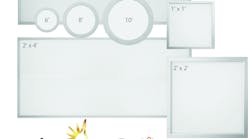Philip Color Kinetics has announced its participation in two high-profile outdoor architectural lighting projects – one that just went live and one that's under construction. The Miami Tower building, that is prominent on the Florida city's skyline, was just retrofitted with 216 RGB luminaires from Philips replacing a variety of metal halide lamps. The retrofit will provide $260,000 savings in energy, maintenance and other costs. Moreover the solid-state lighting project will provide 16 million colors of light and dynamic effects that can be customized for events such as holidays.
Meanwhile The Bay Lights project in San Francisco will use 25,000 white Philips Color Kinetics LED lights in an artistic display intended to celebrate the 75th anniversary of the city's Bay Bridge. The project is to go live next March and will stretch 1.8 miles with lights as high as 500 ft mounted on vertical cables on the suspension bridge. The cost of the project is $8 million, but organizers expect it to add $97 million to the local economy through tourism. Energy is being generated by a ClearPath solar installation to offset the energy used in the display.
We've seen a number of recent LED driver IC announcements. And just as LED makers are designing components for specific applications, the driver IC makers are doing the same thing. For example Diodes Inc just announced the AL5812 IC that is optimized to drive a single string of mid-power LEDs for low-light applications including signage. At the other end of the spectrum, Texas Instruments announced the LM3463 that can drive six strings of as many as 28 LEDs each for high-light-output applications such as street lights and industrial high-bay lights.
In the area of packaged LEDs, Cree announced a second-generation of its XP-E family with the new versions called XP-E2. The components are electrically, mechanically and optically compatible with the prior products yet offer 20% better efficacy. Lamp and luminaire makers can use the new LEDs to deliver brighter versions of existing products or perform minor redesigns and reduce the number of LEDs used in a product.
Edison Opto, meanwhile, announced the new ET-3534 family. The company touts the lumen per dollar advantages of the product line that can operate at up to 3W yet comes in an economical plastic package.




